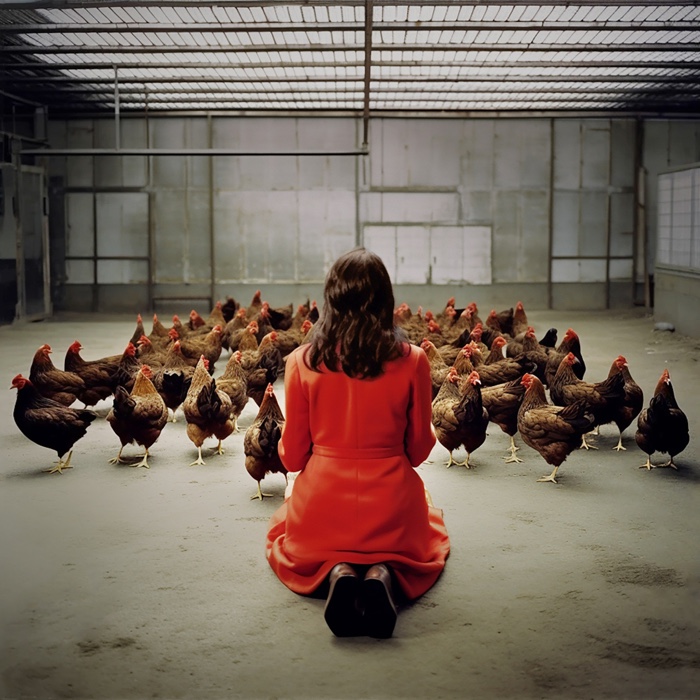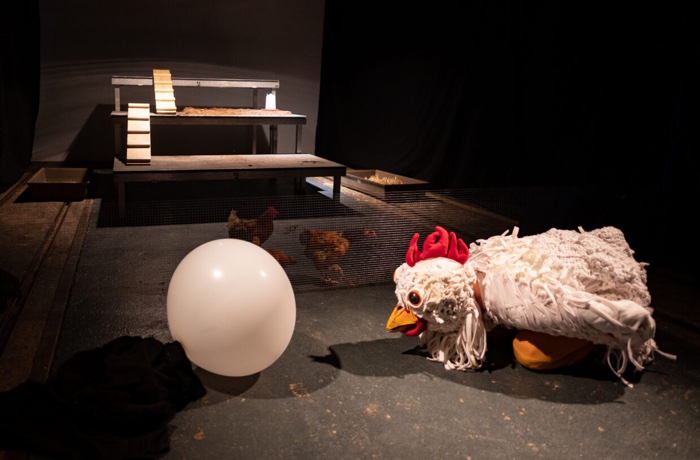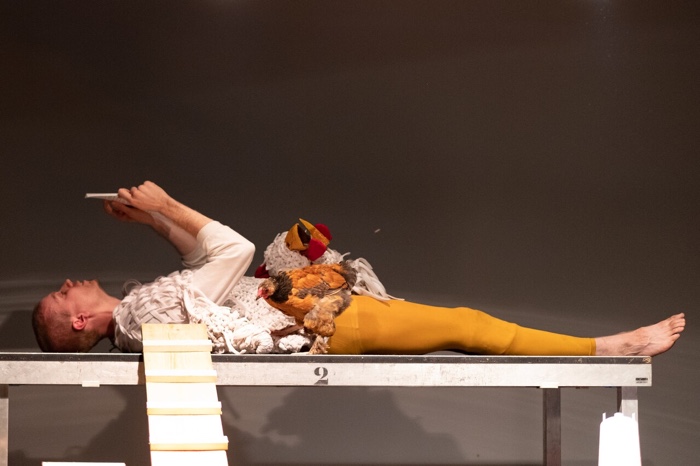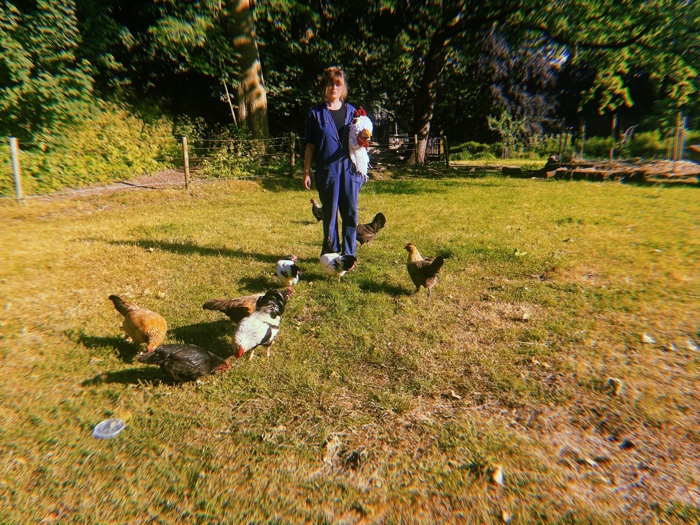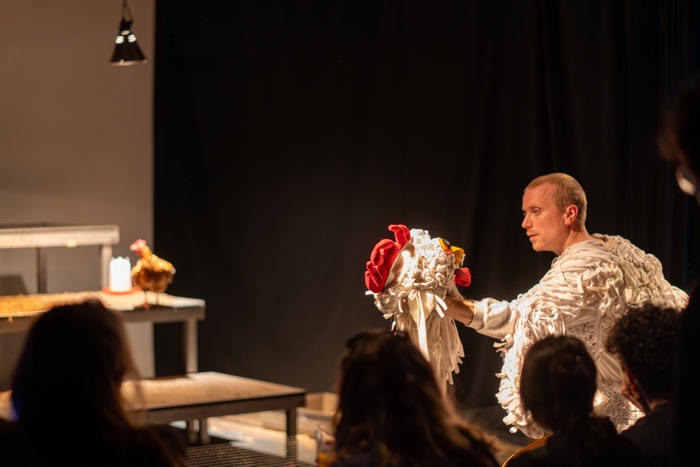Who says that only humans can enjoy art? How about other animals? Chickens, for example. Would they appreciate a theatre performance designed specifically for them?
Anne Hofstra, KIP, 2023
Artist Anne Hofstra believes that anthropocentrism has done enough damage, that we should take a step back and put non-human beings and even the whole ecosystem at the centre of our preoccupations. That’s what she did with KIP (“chicken” in Dutch). The theatre performance is played for an ultra niche audience of 5 chickens. Humans are tolerated, but they are relegated to the periphery of the stage. They can finally experience what being on the margins is like.
To prepare for the performance, the artist read countless research papers, talked with scientists and lived among the chickens for six weeks. She spent the days with them, sang for them, danced for them, fed them, dressed up to look like them (sort of) and tried to figure out what keeps them interested. She learnt along the way that chickens are smart, have complex emotions, that their attention span is fairly short and that humans still haven’t figured out what makes chickens tick. As a result, the theatre performance mixes loose script and improvisations to adjust to the chickens’ mood and whims of the day.
Anne Hofstra, KIP, 2023. Photo: Annelies Verhelst
Anne Hofstra, KIP, 2023. Photo: Annelies Verhelst (via Volkskrant)
KIP was part of the Amsterdam Fringe Festival last year. I didn’t see the performance but I did get a chance to talk with Anne Hofstra , an Artistic Researcher interested in multi species collaborations, cultural relationship to nature and innovative methods for knowledge production.
Hi Anne! How did you come up with the idea for KIP?
It started with this philosophical, almost ideological, idea of ecocentrism. Ecocentrism, as the word itself suggests, is the attempt to put the whole ecosystem (including humans) at the centre of your thinking. Many philosophers and other academics believe that we should move away from anthropocentrism and adopt that perspective. I agree with them. We need to shift our perspective from human-centric to an ecosystem-centred perspective.
I then started wondering how I could integrate that way of thinking into my everyday life. How do you drink a cup of coffee in an ecocentric way? I definitely sensed that we should do that but I wondered how we could translate that idea of ecocentrism into the real world. I then decided I could try and take a small step in that direction by just doing one thing that would not be human-centred. But that still seemed too abstract, so I decided to do just one thing for one other species. Every single decision along the way would consider other species as being like me. There would be no hierarchy and I would try to avoid anthropocentrism at all costs. That became a performance play. I already knew I wanted to do something related to art. I wanted to know if chickens could appreciate art and if we could do art in an eco-centric way. Of course, this is a decision that I made as a human. I had to start somewhere because if you think too hard and wonder, “Is that an eco-centric decision?” then you cannot research whether it could be or can be ecocentric.
From there, I started doing a lot of research and I talked with many scientists. Almost everyone I spoke to told me I was crazy. Or that it was absurd. Which I found exciting because I also found my idea absurd and I wasn’t even sure I’d manage to pull it off.
When I started to read the essays about the cognitive abilities of chickens, I realised that my idea wasn’t completely absurd and that there was actually no study that demonstrated that chickens were not capable of appreciating art. Even the idea that art is only for humans and by humans is little more than an assumption. We like to use art to differentiate ourselves from other animals but it’s not a factual argument.
From then on, I still wasn’t sure I would achieve something relevant but I wanted to take up the challenge. I also realised early on that academic research about chicken is usually funded by the agricultural industry. Which means that the research focused on the welfare of chickens in agricultural settings only. There is an element of distance in those studies. For example, they do not talk about chickens. They refer to them as broilers, a word that designates chickens bred for food.
After I had read so many academic papers, I realised that I needed to experience life with chickens. I was also interested in the rules of creating knowledge in the academic world. I studied literature sciences myself, a field that deconstructs everything and breaks it into tiny parts. The humanities do not have the space for experience in knowledge production. Artists can take up that field, they can use their experience to research and academics can take it from there and use this artistic research to produce knowledge. Otherwise, whole experiences are obliterated.
Why did you choose chickens?
What I like about chickens is that they have a long history with us and there are way more chickens in the world than there are humans. I was also interested in the fact that chickens look dumb to a human eye. If I could do this work for chickens, then I could do it for other species. I also happen to like chickens. Their faces are so different from human faces. Which makes it difficult to anthropomorphise them.
Anne Hofstra, KIP, 2023 (residency at Buitenplaats Doornburgh)
Did you select the individual chickens? According to which criteria? I imagined that you were like a theatre producer doing a casting of actors….
First, the chickens were not the actors. They were the audience!
That’s the core of the whole project.
I didn’t cast the chickens. It simply started with me looking for a residency where there would also be chickens. I also wanted the chickens to live a good life. I didn’t want them to be stressed, I wanted them to be able to walk freely, to find their own food… If they were going to experience art, then it was important that they already enjoyed the basic conditions of chicken happiness.
I was fortunate because there was this residency at Buitenplaats Doornburgh where they have 40 chickens and a really, really big garden with a forest where the chickens could roam freely.
Once I was there, I embarked on a two-month research project where I lived with chickens. I was still sleeping in a bed but as soon as I woke up, I would spend time with the chickens, observe them, sing for them, play for them, dance for them, etc. Scientists helped me set up the research and I was very enthusiastic at first, thinking it would be the best experience of my life. The first few days were indeed amazing. After day 4 or 5, I was starting to feel lonely with the chickens. I was dancing for chickens over and over again. However, they were not reacting in ways that I could make sense of and I started questioning my life decisions. It was though.
Anne Hofstra, KIP, 2023. Photo: Romy Kerkman
Wasn’t it boring too?
Not always. At first, it was fantastic but after a while, I started to realise that even if I could see patterns, I was never sure if they came to me because they liked me, because they liked my dance, because they wanted me to stop dancing or because they knew I might have food for them. I simply could not look inside their heads.
As I said, after the initial enthusiasm, it became difficult for me to continue to show up when I didn’t get that much in return. I was observing them all day, doing small tests, giving them stuff and watching how they reacted. At some point, after over a month or so, I was doubting all my decisions and I felt so lonely. I felt on the ground and I cried, wondering what I was doing….
Did you have someone to talk to about how to engage with chickens? Maybe a farmer working at the residency? Or a scientist you could call for guidance?
I had discussions with scientists on the phone once in a while. There was also someone taking care of the land around the residency but we never conversed much. Otherwise, there was only me. I was taking care of the chickens. I wanted to be one of the chickens. Even though I knew that was not possible.
Anyway, after a month or so, I was sitting on the ground crying. That’s when all the chickens came to me! I realised there was something there, there was a connection between us. From that moment on, the research became interesting again. I could watch them more closely, I could observe better how they reacted to me. I thought it was easier for me to feel empathy because I felt that the chickens and I were somehow connected. I never knew for sure what the reason they came to me was but I could not discard the possibility that they came to me because there was a connection and because they might enjoy the art. I could see some patterns: things they liked and others they didn’t. I started to get a sense of their tastes. Of course, every chicken is different but there was an overall idea of what I could explore with them.
Why the chicken suit? Does it facilitate the interactions between the chickens and the humans? Or was it meant for the appreciation of the human audience?
During my research, I established several variables in my interactions with the chickens. One of the variables was the chicken costume. I realised that they reacted more when I wore it. I don’t think I could fool them with that costume. I could see it got their attention but it is probably because it made me bigger and more visible. That is why we used it in the show.
How the actor, Willem Wits prepare for the performances?
I worked with two people. Playwright Doke Pauwels and actor Willem Wits. At first, I thought that I would perform for the chickens but I realised early on that if I performed, I would be too busy focusing on the performance and would not observe closely enough how the chickens reacted.
Do you know about the setting of the performance?
I only saw photos of it…
The setting of the performance meant that the chickens were in the audience. A few people were sitting on stage. In between, there was the actor. I was next to the stage, directing. The audience could see me but the chickens couldn’t really see me, I was in the dark and the light was on the performers.
There were three parts in the show. I realised during my research that the attention span of chickens is not that big. I also wasn’t sure that everything would work right away. Each of the three parts focused on a message I wanted to pass on to the chickens and would take only a couple of minutes. After that, we would repeat the same sequence, depending on how the chickens would react. The first part featured a really big egg that became smaller. If the chickens were not looking, then I would direct the actor and tell him to make the egg bigger again or use a different music to get their attention again.
Every performance was different from the others. I was always looking at the chickens, at their reactions, wondering how I could bring their attention to a specific topic. We tried different versions and then we would go to the following part which explored a different thematic. The third part was a letter that I wrote to the chickens. The letter was first read in Dutch and then it would be delivered again, but with different intonations. By singing it, for example. Or by uttering noises because you don’t need words to talk to chickens. They don’t speak Dutch. We tried different tactics so that my message would carry across.
You say that chickens do not speak Dutch but can they learn words? Like cats and dogs do?
You can train them just like you can train cats and dogs. I trained my chickens in one thing and that was for safety purposes only: I trained them so that if I clapped, they would come to me. Otherwise, I didn’t want to train them because they were not in a circus. It was important that they didn’t turn into actors. I only wanted to give them an artistic experience that they might like or not but that was intended for them only. That meant that I could not use normal theatre light because it would have made them feel uncomfortable. Humans have a frame rate of around 50, while chickens have a much higher frame rate which means that light that seems normal to us is flickering for them. I had to use different lights, different surfaces, I had to think about their attention span, about the way their eyes are positioned, I had to consider all their senses to make sure that I could translate this human experience into an animal experience. That required a lot of academic information.
When I think about the industrialisation of chicken breeding, i have the feeling that anything goes: there is very little concern for their physical and mental wellbeing. You already mentioned ethics when you talked about the light or the necessity to work with chickens that had a good life. As an artist, did you find that there are specific ethical guidelines you had to follow, apart from the ones you set for yourself?
Yes, definitely. I talked to scientists, I talked to vets, I even talked with a chicken vet to better understand the signals they give, the kind of sound they make when they are happy or when they are stressed, etc. Many people actually said to me: “You shouldn’t pretend that the chickens are humans!” “You shouldn’t project human feelings on chickens, that is stupid”.
I then realised that we create a narrative around chickens, around many animals actually, that is very helpful to humans. According to that narrative, chickens are dumb, they cannot do what we do, they do not have the cognitive abilities that we possess.
Thinking like that is helpful because the way we treat chicken is appalling. The narrative around their stupidity means that it doesn’t matter what we do to them. They don’t realise that we treat them so badly. The idea we have that we shouldn’t project our feelings on other species is part of that narrative.
I also did a lot of research on interspecies empathy. It is very difficult to feel empathy for an individual you do not know, even when that individual is a human. The further someone is from us, in terms of geography or experience, the less easy it is for us to feel empathy. You need to have knowledge about the other person, and even then, you can never fully be sure of what is going on in their mind. Now, when it comes to chickens and other animals, we need to have a lot of scientific data to create an understanding of that species. And from then on, we can use our empathy to fill in all the unknowns.
Throughout my research, I learnt many incredible things about chickens. For example, they are self-aware, they can look at themselves and adapt their behaviour. They can reach logical conclusions on the level of a 7 year old child. They can count. They have a very good memory. They are able to differentiate between around 100 human faces. They have a sense of time and they can anticipate future events. They each have their own personality. They experience emotions like sadness, happiness, but also boredom. They can communicate these emotions with each other. They dream, which suggests that they can see things when they are not in front of them. They can see more colours than humans. They have an extra sense for magnetism. Once we know that they have all these skills, we can use our empathy to better understand them.
I associate everything you describe not with chickens, but with crows. There are countless papers about their intelligence. The cognitive skills of chickens do not seem to attract much interest.
Many birds are actually really smart. They have this avian brain cortex. Many birds have a brain structure that is similar to a mammal’s for art. They also have this extra magnetic sense. They are actually much smarter than we allow ourselves to know.
What is next for you? Any upcoming projects, fields of research or events you could share with us?
Right now, I’m starting a residency where I want to explore whether we can use AI to help us represent the voice of nature. Some people are already trying to do just that at the moment. Most of them are not very good at it. I would like to investigate what it is about humans psychologically that makes us so bad at representing the voice of nature. From there, I would like to make an AI that doesn’t prioritise humans in decision-making and I also want to see if this would help us understand better what the voice of nature is.
Thank you, Anne!
Related stories: What re-engineering the chicken and the cow says about us. An interview with Daniel Szalai, Breeding a Planetary Community Chicken, “Have we met?” A multispecies approach to the planet, Carnevale. Because pigs deserve piñatas and fruit machines too, Talking broiler chicken, germ maps and maggots with Andreas Greiner, The Moon Goose Analogue: Lunar Migration Bird Facility, Interview with Kultivator, an experimental cooperation of organic farming and visual art practice, etc.
